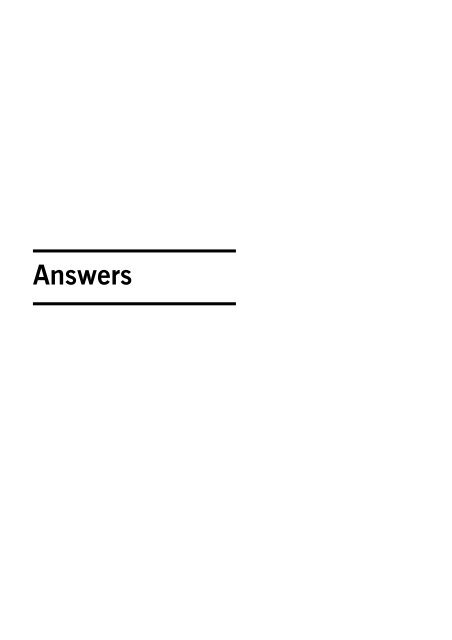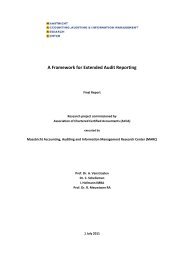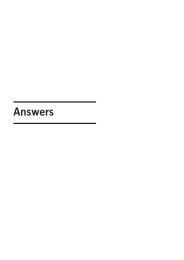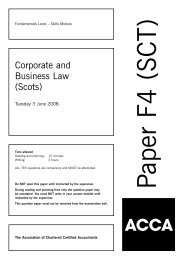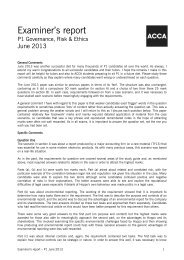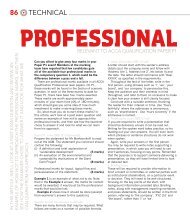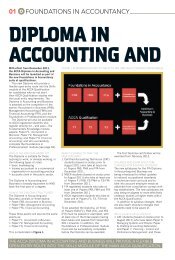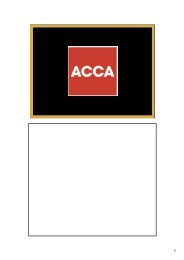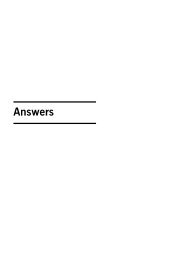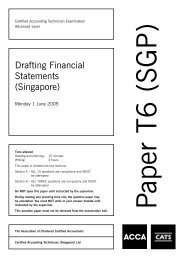Answers - ACCA
Answers - ACCA
Answers - ACCA
Create successful ePaper yourself
Turn your PDF publications into a flip-book with our unique Google optimized e-Paper software.
<strong>Answers</strong>
<strong>ACCA</strong> Certified Accounting Technician Examination – Paper T6 (INT) June 2009 <strong>Answers</strong><br />
Drafting Financial Statements (International) and Marking Scheme<br />
Section A<br />
1 A Berino’s payables 244,000 + Muggie’s payables 40,000 less 6,000 owed to Berino = 278,000; Berino’s receivables<br />
360,000 + Muggies receivables 150,000 less 6,000 from Berino = 504,000<br />
2 A<br />
3 B<br />
4 D<br />
$<br />
Consideration 8,000,000<br />
Fair value of non-controlling interest (3 million x $1·20) 3,600,000<br />
–––––––––––<br />
11,600,000<br />
Less fair value of net assets at acquisition (8,750,000)<br />
–––––––––––<br />
Goodwill 2,850,000<br />
5 D Rent 3,000 + (building insurance 6,000 x 6/12) +loan 10,000 + (interest 10,000 x 5%) = 16,500<br />
6 A (72,000 x 2/12) + (84,000 x 10/12) = 82,000; 84,000 x 2/12 = 14,000<br />
7 D<br />
8 C<br />
9 B (24,000 + ((470,000 – 24,000) x 5%) – 25,000)) = 21,300<br />
10 A<br />
13
Section B<br />
Marks Workings<br />
$000<br />
1 (a) (i) Portsmere<br />
Statement of Comprehensive Income for the year ended 31 May 2009 0·5<br />
Revenue<br />
$<br />
1,482,000 1·0 (1,510 – 28)<br />
Cost of sales (W1) (1,087,400)<br />
–––––––––––<br />
5·5<br />
Gross profit 394,600<br />
Distribution costs (W1) (81,680) 3·0<br />
Administrative expenses (W1) (126,320) 7·0<br />
Finance cost (4,000)<br />
–––––––––––<br />
1·0<br />
Profit before tax 182,600 0·5<br />
Income tax expense (40,000)<br />
–––––––––––<br />
1·0<br />
Profit for the year<br />
Other comprehensive income:<br />
142,600<br />
Gains on land revaluation 12,000<br />
––––––––<br />
1·5 (200 – 188)<br />
Total comprehensive income for the year 154,600<br />
––––––––<br />
1·0<br />
––––<br />
22·0<br />
––––<br />
(ii) Portsmere Ltd<br />
Statement of Financial Position as at 31 May 2009 0·5<br />
$ $<br />
Assets<br />
Non-current assets<br />
Property, plant and equipment (W2) 780,400 4·0<br />
Intangible asset (W3)<br />
Current assets<br />
45,000<br />
––––––––––<br />
825,400<br />
1·0<br />
Inventory 60,000 0·5<br />
Trade receivables 243,200 1·0 (256 – 12·8)<br />
Prepayments 2,000 1·0<br />
Cash and cash equivalents 30,000 335,200<br />
––––––––––<br />
0·5<br />
Total assets<br />
Equity and liabilities<br />
Capital and reserves<br />
1,160,600<br />
––––––––––<br />
$1 Ordinary shares 570,000 0·5<br />
Retained earnings 226,600 1·5 (104 + 142·6 – 20)<br />
Share Premium Account 60,000 0·5<br />
Revaluation reserve<br />
Non-current liabilities<br />
12,000<br />
––––––––––<br />
868,600<br />
1<br />
10% Loan notes<br />
Current liabilities<br />
40,000 1·0<br />
Trade payables 200,000 0·5<br />
Current tax 40,000 0·5<br />
Accruals 12,000<br />
––––––––––<br />
252,000<br />
––––––––––<br />
1·0<br />
Total equity and liabilities 1,160,600<br />
–––––––––– ––––<br />
15·0<br />
––––<br />
14
Workings Cost of Distribution<br />
Marks<br />
Administrative<br />
Sales Cost Expenses<br />
W1 $ $ $<br />
Amortisation of intangible asset 5,000 1<br />
Wages and salaries (40:35:25) 57,600 50,400 36,000 1·5<br />
Insurance ($14,000 – $2,000) 6,000 6,000 1<br />
Energy expenses ($70,000 + $12,000) (50:20:30) 41,000 16,400 24,600 3<br />
Opening inventory 128,000 0·5<br />
Administrative expenses 64,000 0·5<br />
Purchases 884,000 0·5<br />
Discounts received (1 mark) (76,000) 1<br />
Director’s remuneration 56,000 0·5<br />
Depreciation – plant 22,000 1<br />
Depreciation – buildings (50:30:20) 14,800 8,880 5,920 3<br />
Increase in allowance for receivables (1 mark) 4,800 1<br />
Closing inventory (1 mark) (60,000)<br />
–––––––––– ––––––– ––––––––<br />
1<br />
1,087,400<br />
––––––––––<br />
81,680<br />
–––––––<br />
126,320<br />
––––––––<br />
(5·5 marks) (3 marks) (7 marks) (15·5 marks)<br />
W2 Non-current assets Total<br />
Land Buildings Plant<br />
Property, Plant<br />
& Equipment<br />
$ $ $ $<br />
Cost 188,000 592,000 176,000 956,000<br />
Depreciation b/f<br />
Current year’s depreciation:<br />
(48,000) (88,000) (136,000)<br />
Plant ($176,000 – $88,000) x 25% (22,000) (22,000)<br />
Buildings $592,000 x 5% (29,600) (29,600)<br />
Revaluation of land 12,000<br />
–––––––– –––––––– ––––––––<br />
12,000<br />
––––––––<br />
200,000<br />
––––––––<br />
514,400<br />
––––––––<br />
66,000<br />
––––––––<br />
780,400<br />
––––––––<br />
(1 mark) (1·5 marks) (1·5 marks) (4 marks)<br />
W3 Intangible Assets<br />
$000<br />
Cost 50<br />
Amortisation (50/5) * 6/12 (5)<br />
–––<br />
Value as at 31 May 2009 45<br />
–––<br />
(b) Accounting ratios<br />
(i) Earnings per Share<br />
Profit after tax<br />
––––––––––––––––––– =<br />
142,600<br />
–––––––––<br />
No. of ordinary shares 570,000<br />
= 25·0 cents<br />
(ii) Price earnings ratio<br />
Current share price per share<br />
––––––––––––––––––––––––– =<br />
110c<br />
––––– = 4·4<br />
Earnings per share 25c<br />
Marking scheme: 0·5 mark for stating the correct formula and 1 mark for calculating the correct ratio.<br />
15
Marks<br />
2 (a) Black’s accounts<br />
(i) Revaluation account<br />
$ $<br />
Plant and machinery – loss 1,200 Goodwill 14,000 1·0 + 0·5<br />
Capital account 20,300<br />
–––––––<br />
Property – profit 7,500<br />
–––––––<br />
0 + 1·0<br />
21,500<br />
–––––––<br />
21,500<br />
–––––––<br />
(ii) Capital account<br />
$ $<br />
Balance c/f to new business 67,800 Balance b/f 49,500 0·5 + 0<br />
Motor vehicle 2,000<br />
–––––––<br />
Profit on revaluation 20,300<br />
–––––––<br />
1·0 + 0·5<br />
Pool’s accounts<br />
69,800<br />
–––––––<br />
69,800<br />
–––––––<br />
(i) Revaluation account<br />
$ $<br />
Inventory – loss 1,000 Goodwill 10,000 1·0 + 0·5<br />
Plant and machinery – loss 800 0·5<br />
Capital account 8,200<br />
––––––– –––––––<br />
10,000<br />
–––––––<br />
10,000<br />
–––––––<br />
(ii) Capital account<br />
$ $<br />
Balance c/f to new business 38,490 Balance b/f 30,290 1·0 + 0<br />
–––––––<br />
Profit on revaluation 8,200<br />
–––––––<br />
0·5<br />
38,490<br />
–––––––<br />
38,490<br />
––––––– –––<br />
Total 8<br />
(b) Marks Workings<br />
Blackpool<br />
Statement of Financial Position as at 31 May 2009<br />
$ $<br />
Assets<br />
Non-current assets<br />
Property 40,000 0·5<br />
Plant and machinery 35,000 1 ($15,000 + $20,000)<br />
Motor vehicle 9,100 0·5<br />
––––––––<br />
84,100<br />
Current assets<br />
Inventory 9,200 1 ($5,000 + $4,200)<br />
Trade receivables 3,190 0·5<br />
Cash at bank 4,900 17,290 0·5<br />
–––––––<br />
––––––––<br />
Total assets 101,390<br />
––––––––<br />
Capital and liabilities<br />
Capital accounts<br />
Black 49,800 1·5 W1<br />
Pool<br />
Current liabilities<br />
32,490<br />
––––––––<br />
82,290<br />
1·5 W1<br />
Trade payables 15,500 0·5<br />
Loan from Peston 3,600<br />
––––––––<br />
0·5<br />
Total capital and liabilities 101,390<br />
–––––––– –––<br />
Total 8<br />
16
Marks<br />
Working 1<br />
Black<br />
Partners Capital accounts<br />
Pool Black Pool<br />
$ $ $ $<br />
Goodwill written off Balance b/f from<br />
3:1 x $24,000 18,000 6,000 old business 67,800 38,490 1·0 + 1·0 + 0·5 + 0·5<br />
Balance c/f 49,800<br />
–––––––<br />
32,490<br />
––––––– ––––––– –––––––<br />
67,800<br />
–––––––<br />
38,490<br />
–––––––<br />
67,800<br />
–––––––<br />
38,490<br />
–––––––<br />
(c) Main terms that might be included in a partnership agreement:<br />
Capital – The amount each partner will contribute to the business and how long it will be kept in the business.<br />
Profit sharing ratio – How profits and losses will be shared amongst the partners.<br />
Interest on capital – Details of the rate of interest, if any, that partners will be paid on their capital.<br />
Partners salaries – How much, if anything, will be appropriated to partners as salaries.<br />
Withdrawals on account of profit – How much, if anything, partners will be allowed to withdraw from the business during the<br />
year.<br />
Guaranteed minimum profit share – How much of the profit a partner is guaranteed.<br />
Interest on drawings – The notional rate that will be applied to any drawings made by a partner during the year.<br />
Marking scheme: 1 mark for identifying and explaining a term up to a total of 4 marks.<br />
3 (a) The purpose of a conceptual framework is to set out the concepts that underlie the preparation and presentation of financial<br />
statements for external users. It assists with the development of future accounting standards and reduces the basis for<br />
alternative accounting treatments by establishing the principles that should be followed in preparing financial information.<br />
It can also assist preparers and auditors of financial information in dealing with topics that are not subject to an accounting<br />
standard.<br />
A conceptual framework should prevent the accountancy profession from establishing conflicting accounting rules and<br />
practices as standards are developed following the principles set out within the framework.<br />
Marking scheme: Up to 3 marks.<br />
(b) (i) Relevance<br />
Information is considered to be relevant if it has the ability to influence the economic decisions of users and is provided<br />
in time to influence those decisions<br />
(ii) Reliability<br />
Information is reliable if:<br />
(a) it can be depended upon by users to represent faithfully what it either purports to represent or is reasonably<br />
expected to represent and therefore reflects the substance of the transactions and other events that have taken<br />
place.<br />
(b) it is free from deliberate or systematic bias and material error and is complete; and<br />
(c) in its preparation under conditions of uncertainty, a degree of caution has been applied in exercising the necessary<br />
judgements.<br />
(iii) Comparability<br />
Information is comparable if it enables users to determine and evaluate similarities in, and differences between, the<br />
nature and effects of transactions and other events over time and across different businesses.<br />
(iv) Understandability<br />
Information is understandable if its significance can be appreciated by users that have a reasonable knowledge of<br />
business and economic activities and accounting and a willingness to study with reasonable diligence the information<br />
provided.<br />
Marking scheme: ½ a mark for identifying and up to 1·5 marks for explaining the characteristic. Maximum of 8 marks.<br />
(c) The arguments for having accounting standards<br />
Standards oblige companies to disclose the accounting policies they have used in the preparation of accounts. This should<br />
help the users of accounts better understand the information presented.<br />
17
Accounting standards require companies to disclose information in the financial statements which they might not want to<br />
disclose if the standard did not exist.<br />
Accounting standards reduce the number of choices in the method used to prepare financial statements and therefore they<br />
should reduce the risk of creative accounting. This should help the users of financial statements to compare the financial<br />
performance of different entities.<br />
Accounting standards provide a focal point in the accounting profession for discussion about accounting practice.<br />
Accounting standards should increase the credibility of financial statements with the users by improving the amount of<br />
uniformity of accounting treatment between companies.<br />
Marking scheme: 1 mark for each relevant point up to 5 marks.<br />
(d) It might be acceptable to depart from accounting standards if the entity makes the following disclosures:<br />
(i) The management have concluded that the financial statements present fairly the entity’s financial position, financial<br />
performance and cash flows;<br />
(ii) that it has complied with applicable standards, except that it has departed from a particular requirement to achieve a<br />
fair presentation;<br />
(iii) the title of the standards from which the entity has departed, the nature of the departure, including the treatment that<br />
the standard would require, the reason why that treatment would be so misleading in the circumstances that it would<br />
conflict with the objective of financial statements set out in the Framework, and the treatment adopted; and<br />
(iv) for each period presented, the financial effect of the departure on each item in the financial statements that would have<br />
been reported in complying with the requirement.<br />
Marking scheme: 1 mark for identifying each relevant comment up to 4 marks.<br />
18


